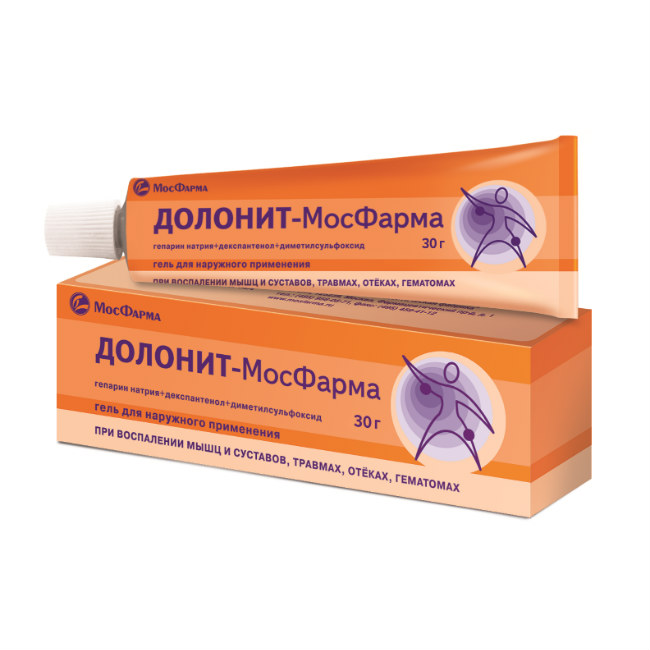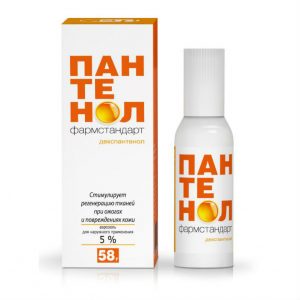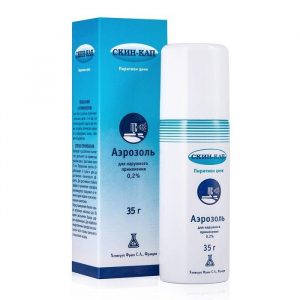Description
Pharmacological action of
The action of the drug is due to its active substances: dimethyl sulfoxide, sodium heparin and dexpanthenol.
Dimethyl sulfoxide (DMSO)
DMSO has anti-inflammatory, decongestant, and topical analgesic effects.
Anti-inflammatory activity is associated with some pharmacological effects, the most significant of which is the inactivation of hydroxyl radicals, which are produced in large quantities during the inflammation process and have a destructive effect on tissues.
DMSO has a local analgesic effect by reducing the rate of nociceptive (pain) impulses in peripheral neurons.
Decongestant effect is provided by inactivation of hydroxyl radicals and an improvement in the subcutaneous metabolic reaction at the site of application of the drug. To a certain extent, the hygroscopic properties of DMSO are also responsible for its decongestant effect.
DMSO (from 50% or more) penetrates biological membranes, including through the skin, contributing to a better and deeper penetration into the tissues of other drugs used simultaneously.
Heparin sodium
Heparin sodium, which is part of the preparation, is a direct anticoagulant due to inactivation of biogenic amines in the tissue, exhibits a distinct anti-inflammatory effect, and improves local blood circulation. Heparin sodium inhibits the action of hyaluronidase and, thereby, effectively promotes the regeneration of connective tissue.
Heparin sodium exhibits a dose-dependent antithrombotic effect, enhancing the inhibitory activity of antithrombin III on the activation of prothrombin and thrombin. Penetration of heparin sodium through healthy skin is dose-dependent and is confirmed for dosage starting at 300 IU / g.
Dexpanthenol
Dexpanthenol exhibits anti-inflammatory and dermatoprotective effects, stimulates regeneration processes. After absorption, it turns into pantothenic acid, which is involved in numerous metabolic processes, being an integral part of coenzyme A and, due to the improvement of granulation and epithelization processes, promotes the regeneration of damaged skin areas.
Pharmacokinetics
Dimethyl sulfoxide (DMSO)
DMSO enters the systemic circulation, the half-absorption period is 3-4 hours. DMSO passes into breast milk. Eliminated mainly with urine.
After 6 hours after application of the drug, Cmax in plasma reaches 120 ng / ml and persists until 12 hours after use. After 60 hours after application, the concentration of DMSO in blood plasma reaches a physiological level of 40 ng / ml.
12-25% of the absorbed DMSO is excreted within the first 24 hours and 37-48% is excreted within 7 days unchanged through the kidneys or as a metabolite (dimethyl sulfone).
3.5-6.0% of all DMSO is excreted through the lungs in the form of dimethyl sulfide, 6-12 hours after the use of the drug.
When using 1 g of DMSO 3 times / day for 5 days, its average content at the site of application to the skin is 3 mg / g, the average content in the underlying muscle tissues and the synovial membrane at the site of the synovial connection is 7-10 Ñg / ml, synovial fluid – 0.8 mcg / g. The concentration of DMSO in blood plasma is 0.5 Ñg / g.
T1 / 2 DMSO from blood plasma is 11-14 hours.
Heparin sodium
Heparin sodium quickly penetrates the skin within the first hour after application of the gel, the concentration in the underlying tissues corresponds to the concentrations achieved after iv administration of 5000 IU of heparin. Heparin sodium does not cross the placental barrier and does not pass into breast milk.
Dexpanthenol
When applied topically, dexpanthenol is transformed in the skin into pantothenic acid, which has a lower rate and degree of transdermal penetration than dexpanthenol.
Indications
Edema, hematomas and inflammations of soft tissues, muscles, tendons, tendon sheaths and ligaments after bruises, squeezing, injuries
closed injuries, bruises
joint injuries with damage to the ligaments
shoulder-shoulder periarthritis and shoulder epicondylitis (tennis elbow), tendonitis (inflammation of the tendons), tendovaginitis (inflammation of the tendon sheaths), bursitis (inflammation of the mucous membranes of the joints)
acute neuralgia.
Contraindications
Hypersensitivity to one of the gel components (active / excipients)
severe impaired liver and / or kidney function
bronchial asthma
severe cardiovascular disorders (IV functional class of angina pectoris according to the classification of Canadian cardiocardial infarction society , stroke, severe generalized atherosclerosis)
pregnancy
breastfeeding
children under 5 years old.
Do not apply the drug to mucous membranes (eyes, nose, mouth), open wounds, or damaged skin (for example, after irradiation or severe sunburn, fresh postoperative scars).
Special instructions
The drug is used sparingly, quickly penetrates the skin and does not leave a greasy layer on the skin and stains on linen. Thanks to the alcohol (ethanol) that evaporates after applying the gel, pleasant cooling is felt at the place of application of the drug.
A pleasant cooling effect is enhanced if the gel is stored in the refrigerator, as well as if the drug is used in hot weather (due to increased evaporation of alcohol).
The area of the skin on which the preparation is applied must be cleaned of dirt, cosmetics, other medicines and chemicals.
When using dressings, wait a few minutes after applying the gel, so that the bulk of the gel is absorbed and the ethanol (ethanol) evaporates. This is especially important in cases where a bandage is poorly permeable to air.
During treatment with the drug, photosensitivity of the skin may increase, therefore, during its use, intensive sun baths and visits to the solarium should be limited.
In case of skin reactions, treatment should be discontinued.
Due to its high absorption of dimethyl sulfoxide, Dolonit-MosFarm should not be used in combination with other ointments and gels.
It should be remembered that getting the drug on open wounds causes a painful reaction, because the gel contains ethyl alcohol (ethanol).
Influence on the ability to drive vehicles and control mechanisms
The drug for cutaneous use does not affect the ability to drive vehicles and engage in other potentially dangerous activities that require an increased concentration of attention and speed of psychomotor reactions.
Composition
Gel for external use is colorless, transparent or slightly opalescent, uniform, with a characteristic odor.
100 g
heparin sodium 50,000 IU
dexpanthenol 2.5 g
dimethyl sulfoxide 15 g
Excipients:
carbomer homopolymer type C – 1 g,
trometamol – 0.2 g, macrogol glyceryl hydrochloride – 0.9%, 0.3% – 0.3%
rosemary oil – 0.2 g,
pine needles oil – 0.25 g,
lemon oil – 0.05 g,
purified water – up to 100 g.
Dosage and administration
The preparation is applied with a thin surface layer on the skin over the area of damage to soft tissues, joints or tendons (edema, hematoma, inflammation, trauma) and is evenly distributed with light rubbing movements.
In order to cover the entire surface of a bruised knee, it is usually sufficient to squeeze 3-4 cm of gel from the tube.
The procedure is repeated 2-4 times / day for 7 days or until the disappearance of symptoms of the disease, such as pain, swelling, swelling, inflammation.
If within 7 days of treatment there is no clear improvement, the patient needs to see a doctor.
When applying dressings with a gel, a breathable dressing is applied only after most of the gel has penetrated the skin and the alcohol has evaporated (several minutes).
Dolonite-MosFarma and iontophoresis
The drug can be used for iontophoresis. The sodium heparin contained in the preparation in the solution is an anion. Application of the drug to the cathode promotes increased penetration of sodium heparin into the affected area, and dimethyl sulfoxide exhibits a synergistic effect with the effect of electric current (anesthesia, reduction of local edema).
It must be remembered that electric shock treatment itself can cause local skin irritation reactions. Therefore, it is necessary to carefully follow the instructions of the manufacturers of devices so that the use of the drug does not enhance local reactions.
Always pay attention to the adequacy of the electrode coating with a damp sponge.
Dolonit-MosFarma and ultrasound (phonophoresis)
This drug is a good contact gel for the treatment of ultrasound (phonophoresis). The active ingredients of the gel (dimethyl sulfoxide and sodium heparin) complement the therapeutic effect of ultrasonic waves.
Side effects
The drug is usually well tolerated, but in rare cases local skin reactions (redness, itching and burning sensation at the site of application) are possible, which usually gradually disappear during treatment.
Sometimes, due to the content of DMSO or other components of the drug, a common skin allergic reaction with urticaria and Quincke’s edema may occur.
In rare cases, during the use of the drug, some patients may smell garlic from the mouth, due to the presence of dimethyl sulfide, a metabolite of dimethyl sulfoxide. This smell indicates good absorption of dimethyl sulfoxide. In some patients, after applying the gel, a change in taste may appear, which disappears after a few minutes.
It is extremely rare when applying the drug to large areas of the body that nausea, diarrhea, shortness of breath, headache, and chills are possible.
Overdose
Cases of overdose and poisoning with the drug are not described.
Storage conditions
The drug should be stored out of the reach of children at a temperature not exceeding 25 ° C.
Expiration
3 years.
Active ingredient
Sodium heparin, Dexpanthenol, Dimethyl sulfoxide
Conditions of release from drugstores
Without a prescription




